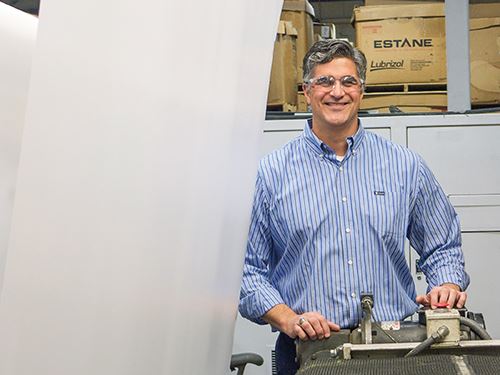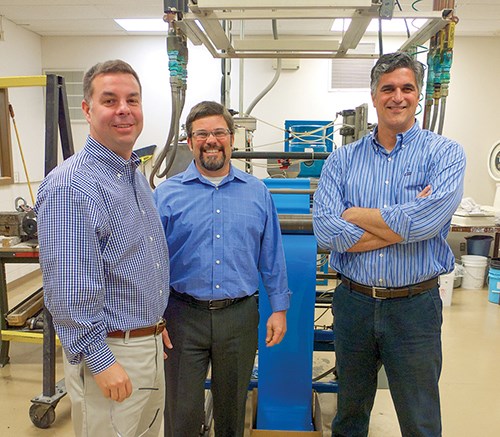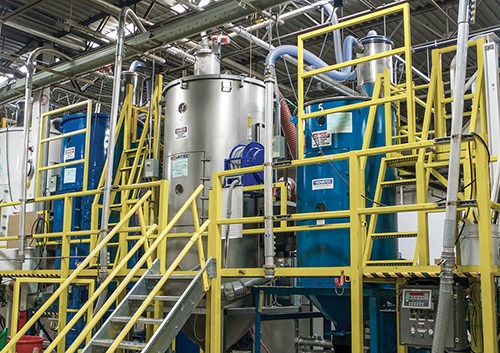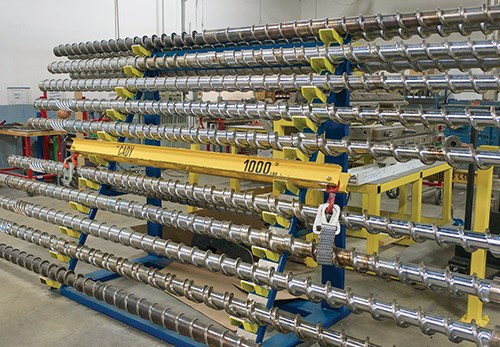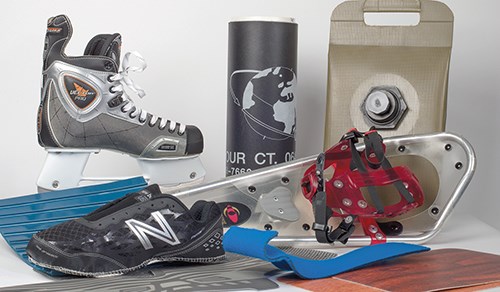On Site: 140 Years…And Growing Stronger
Now in its fifth generation of family ownership, this sheet extruder isn’t all about output. Its focus is on creating solutions in highly customized markets that aren’t immediately associated with sheet.
When you think of sheet extrusion, the first things that likely come to mind are thin structures for packaging applications like cups and trays, or thicker structures for industrial applications. But ice skates, orthopedics, sneakers? Those are among the more curious end markets served by Bixby International of Newburyport, Mass., whose roots go deeper than some trees.
Bixby was founded in 1874 and is now in its fifth generation of family ownership. That in itself is unique: Most family-business management experts will tell you that by the third generation, a company usually has either been sold or gone out of business. But this one has persevered while adapting. It originally operated in Haverhill, Mass., as a footwear manufacturer, supplying multi-material structures used for shoe heels and toes.
But much of that business migrated to Asia over the years, and Bixby opted not to chase it. Instead, it evolved and diversified into a highly engineered, project-oriented sheet extruder whose focus is to generate solutions, not pounds.
“Footwear is still part of our business, but far less than what it used to be,” states Dan Rocconi, Bixby’s president and CEO. “We think our heritage is in engineering. We developed cutting-edge technologies in footwear. In fact, we were the first to use plastic in toe supports and heel counters. Fact is, many shoe manufacturers have built their production process around ‘Bixby’s.’ But as demand and technology changed, we had to change with it to become a top-of-the-line sheet extruder.”
Footwear currently comprises about 18% of Bixby’s business, which is projected to reach $20 million this year. It also participates in a wide range of other markets, where it extrudes a gamut of materials and adhesives onto a variety of fabrics for applications in dental retainers and alignment devices, orthopedic foamed-back braces, conveyor belting, solar EVA encapsulants, protective flooring, and recreational and sporting goods. “We end up in markets that a lot of other companies try to avoid because of the extent of engineering that’s involved up front,” says Marc Gagnon, v.p. of R&D and product development.
“Each project is different, so each solution is different,” Gagnon continues. “As a company, we look at ourselves as the hub of the wheel in any project. The spokes are the scientists and engineers we interact with every day—at resin companies, fabric mills, compounders, adhesive companies, and the like. We work with 16 different compounders, for example, and with companies that specialize in slitting, winding, and sewing all kinds of fabrics. We bring together the intellectual firepower of all of the companies in order to develop highly tailored solutions.”
Adds Dennis Lauzon, v.p. of sales, “Our business is not based on responding to RFQs. In fact, most of the leads we get are from our suppliers asking us if this or that is possible.”
Among its more unusual products is one tradenamed BixCure. This is an optically transparent, UV- and weather-stable, fast-curing EVA solar encapsulant. It was developed to optimize adhesion to a broad spectrum of substrates used in manufacturing photovoltaic modules, both rigid and thin-film constructions. Its balance of properties enables end users to realize greater power retention after accelerated UV and weathering exposure. BixCure can be extruded onto customer-specified substrates such as glass scrim or other films to reduce manufacturing steps.
Another product, called BixTherm, is an optically transparent, highly UV- and weather-stable TPO solar encapsulant. It also adheres to a broad range of substrates used for photovoltaic modules, primarily for thin-film applications where the encapsulant must bond in a continuous, roll-to-roll process.
As a thermoplastic, BixTherm requires only heat and pressure, with no curing, to encapsulate photovoltaic cells and bond to substrates. It does not require long cycle times to build crosslink density. No curing reaction means fewer by-products generated during lamination, and no bubbles formed when using aggressive lamination temperatures and rates. Since it is not based on EVA, there is no corrosive acetic acid generation, which can decrease solar cells’ efficiency over time. It can be supplied as an unsupported film or extruded directly onto solar-film sub- or superstrates, like ETFE, polyester, glass scrims, or customer-specified films.
BixForm BX is a proprietary thermoplastic compound that is extruded and sold as film and sheet products. Sheets of BixForm BX can be heated at low temperatures (with roughly 170 F tap water) and formed to any shape, with a hand and feel like clay. After forming, the product cools quickly into a rigid polymer similar in stiffness to ABS or polypropylene. BixForm BX has even been injection molded into 3D products that are reheated for fine-tuning and customizing the final product’s shape.
BixForm BX can be made with any surface finish (glossy, matte, embossed) or laminated with fabric, felt, foam, or adhesive on one or both sides to give additional aesthetic appeal or functionality.
BixForm BX is processed at widths up to 72 in. from only a few mils to more than 200 mils thick. The resin can also be formulated in any color or with common polymer aesthetic effects. Once formed, BixForm BX has a modulus of 200,000 psi, like that of rigid PP.
A variation of this product, BixForm HiMod, is another proprietary thermoplastic compound formulated by Bixby that is extruded and sold as film and sheet products. Sheets of BixForm HiMod can be heated at low temperatures in hot air or hot tap water and formed to any shape, with a hand and feel like clay. After forming, the product cools quickly into a rigid polymer with the stiffness of a reinforced engineering plastic.
BixForm HiMod has surface-finish, coloring, and laminating versatility similar to the BX version. BixForm HiMod is processed to 72 in. wide and up to 200 mils or more thick. Once formed, BixForm HiMod has a modulus of 500,000 psi, similar to many reinforced engineering polymers.
Newer developments include modifying sheet functionalty for specific barrier properties, conductivity, coefficient of friction, and thermal resistance.
IT’S NOT ABOUT THE POUNDS
These solutions are produced at a 100,000 ft² facility in Newburyport that employs more than 50 people. Bixby has three flat-die extrusion lines and runs six extruders supplied by Davis-Standard, Pawcatuck, Conn. It can run to 48 in. wide on one line, processing up to five distinct layers (polymer, adhesive, and fabric) in a single pass. It’s 60- and 72-in.-wide lines can run up to three distinct layers in a single pass. Bixby’s production runs three shifts around the clock Monday-Friday.
Bixby can run a variety of rolls on each line, depending on the finish required—including one that applies a 3D “waffle pattern” on the sheet—and changes screws often. All dies feature auto-gauge control. Materials are all fed right at the roll-nip point, and all lines can be set up to coat either side of the fabric.
Notes Rocconi, “We’re not the typical extrusion house with dedicated lines that run the same thing every day. We regularly pull screws, dies, and rolls. In a lot of ways, our manufacturing setup is more akin to an injection molder than an extruder. In a week, on each line, we can do four to six changeovers. Our mantra is fast and flexible.”
Extruders feed crosshead dies to facilitate production of multi-layer structures and changeovers. Gagnon refers to Bixby’s brand of processing as “plug-and-play” extrusion. It has hundreds of SKUs within dozens of product families.
Bixby runs a wide range of materials and adhesives. These include all types of polyolefins, TPEs, TPUs, TPVs, various polyesters, polycarbonate, nylon, acrylic, EVAs, and ionomer. Its lamination substrates include foams, woven fabrics, nonwovens, and films made from polyolefins, PET, PVC, nylon, and more. Bixby dries material centrally on dual-bed desiccant dryers furnished by Novatec, Baltimore. Each line is equipped with a gravimetric blender furnished by AEC, Schaumburg, Ill.
A disciple of continuous improvement, Bixby has audit sheets that operators reference for each run. It has also organized its manufacturing floor to minimize turnaround times by storing screws on racks, and its die and adapter systems on wheeled carts. Two years ago, Bixby received a Lean Manufacturing Grant through the state of Massachusetts. “We have learned a lot of best practices as a result,” says Rocconi. “We practice what’s called SMED, short for single-minute exchange of die.” This lean manufacturing technique is based on getting from order to order as quickly as possible.
The nature of its business requires Bixby to focus heavily on R&D, material science, processing, and application development. Away from the manufacturing floor, Bixby has lab-scale pilot manufacturing to produce prototype film and sheet and roll stock. The pilot line creates single- and multi-layer extruded applications from any commercially available thermoplastic, compound, blend, or alloy, including Bixby’s proprietary formulations and adhesives.
The pilot line feature a 1.5-in. Davis-Standard extruder and a three-roll casting/nip station. Prototype sheet samples can be generated up to 18 in. wide at thicknesses from about 3 to 155 mils. This line can run up to seven layers of polymer laminated with all types of substrates. Available textures include gloss, brushed, light matte, heavy matte, diamond, or custom.
The lab line runs one shift five days a week. “Because our business is so customized, it’s very important for us to have proof-of-concept capabilities,” says Gagnon. “We’ll typically run several trials before scale-up. And we have engineers running our lab lines. We’ll work with a compounder on a custom formulation. We’re in the business of offering speedy solutions. If a customer comes to us with a problem or challenge, or perhaps needs a different mix of properties or functionality, our goal is to present them with several options within two weeks.”
Bixby also has an extensive range of laboratory equipment for characterizing mechanical, thermal, rheological, and optical properties, application testing; and post-processing characterization. Rocconi says plans are in the works to increase its R&D efforts.
“For years we’ve been the ‘best-kept secret’ in extrusion,” Rocconi says. “But we work with lots of Fortune 100 companies, and often projects we initiate within one of these companies winds up cutting across a variety of their product lines. I think our experience in processing, materials, and applications matches up with anyone’s.”
Related Content
Roll Cooling: Understand the Three Heat-Transfer Processes
Designing cooling rolls is complex, tedious and requires a lot of inputs. Getting it wrong may have a dramatic impact on productivity.
Read MoreMaking Gains in the Drain Game
AWD blends extrusion and thermoforming technologies with plenty of home-brewed equipment and processes to keep water away from where it isn’t supposed to be.
Read MoreExtrusion Excellence: This Year's Top Stories
Revisit the year’s most popular articles on extrusion technology and processes, showcasing innovations, best practices, and the trends that captured the plastics processing community’s attention.
Read MoreRohm, SABIC Combine on New Film, Sheet Unit
Called Polyvantis, new firm to be a global powerhouse in PC and PMMA extrusion.
Read MoreRead Next
Beyond Prototypes: 8 Ways the Plastics Industry Is Using 3D Printing
Plastics processors are finding applications for 3D printing around the plant and across the supply chain. Here are 8 examples to look for at NPE2024.
Read MoreMaking the Circular Economy a Reality
Driven by brand owner demands and new worldwide legislation, the entire supply chain is working toward the shift to circularity, with some evidence the circular economy has already begun.
Read MoreSee Recyclers Close the Loop on Trade Show Production Scrap at NPE2024
A collaboration between show organizer PLASTICS, recycler CPR and size reduction experts WEIMA and Conair recovered and recycled all production scrap at NPE2024.
Read More

